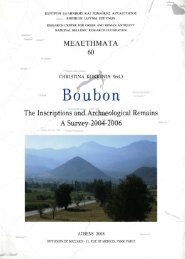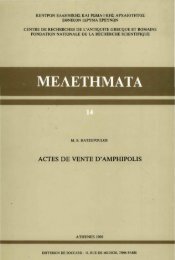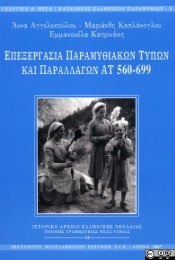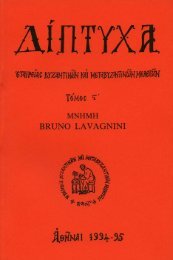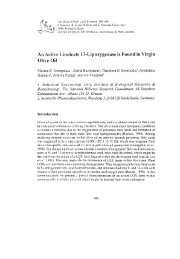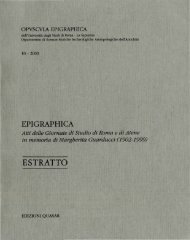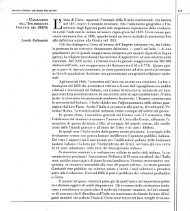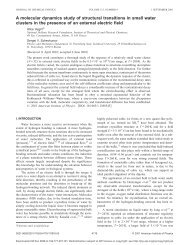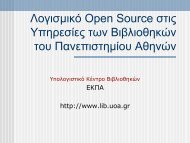roman name-formula
roman name-formula
roman name-formula
- No tags were found...
Create successful ePaper yourself
Turn your PDF publications into a flip-book with our unique Google optimized e-Paper software.
Roman citizens before their discharge and/or<br />
receiving the diplomata: when the recipient's<br />
praenomen differs from his father's (no example<br />
known as yet among the "Eastern" bearers of the<br />
CNF), and when the recipient's rank was high<br />
enough (e.g. centuno cohortis, AD 83) to imply<br />
the possibility of a translatusex legione. All other<br />
CNF of the "Oriental" auxiliaries' bronzes were<br />
invented, in Mócsy's opinion, by the provincial<br />
officials at the moment of the future soldier's<br />
probatio. In order to give the tiro a <strong>name</strong> conforming<br />
to Roman taste and usage, those clerks<br />
replaced the tiro 's original <strong>name</strong>s —even if he<br />
bore a PNF— by a CNF; Mócsy was inclined to<br />
believe that the recruit's Greek or "barbarian"<br />
cognomen (or principal <strong>name</strong>, if the man was a<br />
peregrine) also had to be changed on that occasion.<br />
According to the Hungarian scholar's reasoning,<br />
the majority of the soldiers whose <strong>name</strong>s are<br />
enumerated supra may have been peregrines till<br />
the day of becoming aere incisi^. Mócsy probably<br />
reckoned very much on that possibility (which<br />
depends on his theory that the tria nomina need<br />
never presuppose their bearers' status of cives<br />
Romani) as purely Roman cognomina prevail in<br />
our catalogue.<br />
Various considerations run counter to Mócsy's<br />
hypothesis, however. They may be envisaged in<br />
three groups, which concern (I) general indications<br />
that, in the diplomata at least, the CNF tended to<br />
denote cives Romani; (II) the data about the<br />
recipients' family (filiation; the <strong>name</strong>s of their<br />
wives and/or children, when noted) found at the<br />
end of the diploma texts; and (III), indirect information<br />
about their citizen status that can be obtained<br />
from their origines. While partly aware of the<br />
difficulties presented to his theory by (I) and (II),<br />
Mócsy did not discuss (III).<br />
(I)<br />
There can be little doubt that Roman citizens<br />
did appear —and increasingly, with time— in the<br />
circle of the candidates for the auxiliary diplomata.<br />
That tendency led i. a. to the introduction c. AD<br />
140 of the qui eorum non haberent in the clause<br />
(Imperator ...equitibus et peditibus...) civitatem<br />
Romanam... dedit. Some features of the epikrisis<br />
documents seem to point in the same direction<br />
34<br />
S.DUSANIC<br />
and imply that citizenship was acquiredby certain<br />
aere incisi from auxilia "during (or at the end of)<br />
their military service" but before their candidature<br />
to diplomata 19 . Admittedly, a natural inference<br />
from such a state of affairs is that the CNF appertained<br />
to that class of recipients whose citizen<br />
status (either inherited or acquired during service)<br />
and frequency made the authors of the constitutiones<br />
underlying the diplomata introduce the qui<br />
eorum non haberent modifier 20 .<br />
This inference gains probability with regard to<br />
two facts: in pre-Domitianic times, the CNF is absent<br />
from the "personal" part of the texts of diplomata<br />
for auxiliaries, which cites the PNF only; the<br />
simultaneous use of both onomastic <strong>formula</strong>e<br />
continues from Domitian's reign into the late<br />
Antonine epoch, and probably beyond it. If the<br />
use of the CNF had been officially permitted to<br />
those aere incisi who did not possess Roman<br />
citizenship before obtaining their bronzes, we<br />
should expect the PNF to occur there rarely or<br />
never, especially in the post-140 period. The effect<br />
of the actual evidence being quite different, it is<br />
hard to accept Mócsy's contention that the CNF's<br />
value, in diplomata, was cultural rather than legal.<br />
The civitas Romana gradually spread to the provinces;<br />
this was due to immigration from Rome<br />
and Italy (and the propagation of the immigrants'<br />
descendants, clients, freedmen), as well as to the<br />
generosity of the Emperors, the provincial governors<br />
and other notables. The notion that cives<br />
Romani could and should serve in auxiliary units<br />
18. RMDHQ431tt\, especially 4501. 4561. 461-3. Cf.<br />
Mócsy, Klio52 ( 1970) 287ff. Similar ideas were expressed<br />
by Mommsen (the preceding note), Kraft (who believed<br />
L. Cassius, AD 93, and P. Insteius, AD 98, were peregrines<br />
—because of their <strong>name</strong>-<strong>formula</strong>e) andsome other scholars.<br />
See the critical observations of Holder and Saddington cited<br />
in the preceding note.<br />
19. RMDHQ222 (Dusanic).<br />
20. Cf. XVI 38 (AD 93), with a similar modifier (qui<br />
peregrinae conditionis probati erant) regarding the aere<br />
incisi from the coh. VIII voluntariorum civium Romanorum<br />
(Dalmatia).



